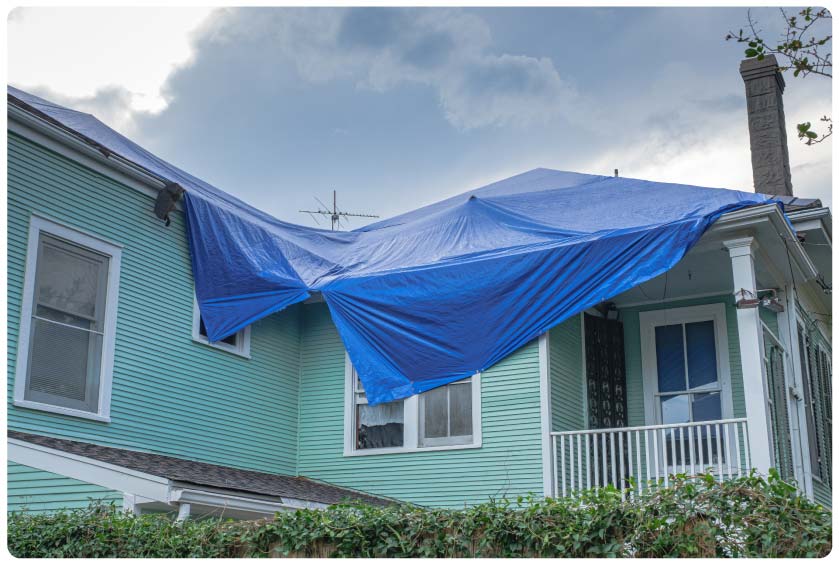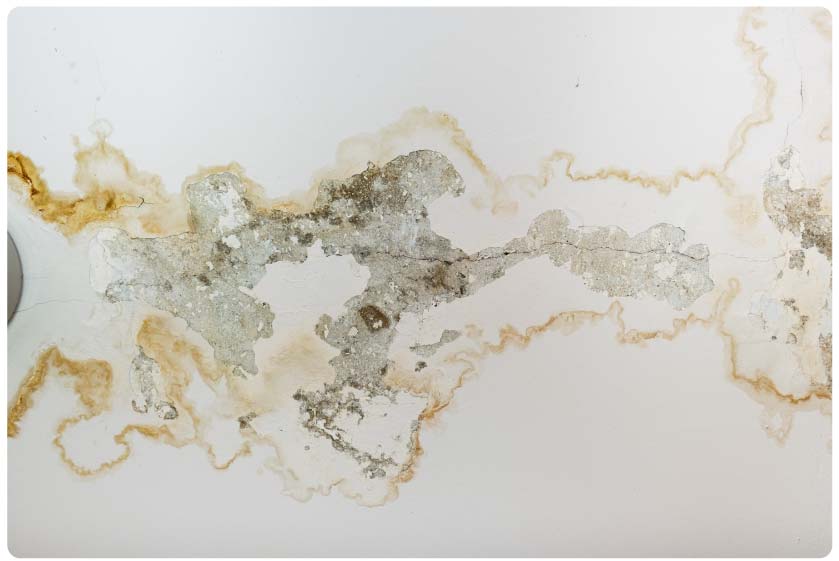How Roof-Tarp Leaks Turn Into Mold

Traditional tarps may be a cheap, quick method for covering a damaged roof, but the risk of leaks makes them far from ideal. Regular tarps can easily allow water to slowly but steadily work its way down from your attic all the way down to the foundation. This inadequate protection can lead to structural damage, wiring shorts, and mold growth.
Mold thrives in damp, dark environments, and a leaky roof along with wall voids and other out-of-the-way spaces create the perfect conditions. Once mold takes hold, it can spread throughout the structure and even into the HVAC system. As the mold spores are dispersed from the vents, they can contaminate furniture, carpet, and clothing. Worst of all, that mold becomes airborne and pollutes the air you’re breathing.
So now that you know how leaks from a damaged roof can cause mold and other issues, it’s time to see what causes those dangerous leaks.
What Causes Leaks in Roof Tarps
Minor roof leaks can be tough to spot, but they can cause mold and significant damage over time. Seeing mold in your attic may be the first sign you have a problem, and tracking down where the leak is coming from can be a challenge. So, where do these sneaky leaks come from? Traditional blue tarps and other temporary roof covers used for roof damage are simply not the right tools for the job. From securing tarps to a damaged roof to providing comprehensive protection, regular tarps fall short across the board for a variety of reasons, including:
Nails and Other Fasteners
Any temporary roof cover must attach securely to your roof, and when you use tarps, that means nails and other fasteners. The problem with fasteners is that they put even more holes in your roof than you started with! Nailing tarps to an already damaged roof is just asking for more damage, leaks, and mold.
Tears and Other Damage
Traditional tarps aren’t typically durable enough or thick enough to resist tears, premature wear, and other issues. Tarps can quickly wear thin as they rub against your roof, especially when they don’t provide a tight fit. Once a tarp is worn or torn, leaks aren’t far behind. Damaged tarps will likely need replacing to prevent further leaks, which can mean, you guessed it, even more nails or fasteners.
Inadequate Coverage
The best temporary roof cover after you get roof damage is one that provides comparable coverage and protection provided by a permanent roof. From intrusive fasteners to overlapping sections, traditional tarps simply can’t provide the coverage your roof needs — but a seamless barrier using shrink wrap roofing can. No worrying about loose shingles, damaged flashing, and most of all, leaks.
Is Mold From Roof Leaks That Bad?
Mold from a leaky roof can lead to serious health issues, especially for people with high respiratory sensitivity, including those with allergies, asthma, and other breathing problems. Mold spores can continue to spread if they’re not contained, meaning you could end up needing mold remediation AND a way to stop the leaks.
Even after the roof leaks are addressed, and mold growth stops, the stains and discoloration can remain, leaving you with a less than desirable environment and a lower property value. If you get mold from roof leaks, your health and the health and value of your property are at risk.
How to Get Rid of Mold From a Leaky Roof

Mold remediation can involve a sometimes lengthy containment process, along with significant repairs both structurally and aesthetically. First, the roof leaks must be remedied by a roofing contractor or disaster response service. Second, mold growth must be stopped with a fungicide. Third, your property may require significant drying out, which could mean dehumidification, and other specialized equipment is needed.
These types of repairs and remediation aren’t cheap, but they are necessary if you let things get too far. While it’s true that any roof damage insurance claim could leave you waiting and worrying until the claim is settled, you don’t have to play that game. Temporary measures to prevent further damage and mold from a leaky roof are usually left up to the property owner after a disaster.
How to Prevent Mold and Further Damage After Roof Damage
After a disaster, a damaged roof is a danger that must be remedied quickly and professionally. That’s why SMART-TARP created our unique disaster response service that provides unequaled protection with our shrink wrap temporary roofing system.
Instead of worrying about leaky tarps, mold, and other issues with your damaged roof, we have a better idea. SMART-TARP’s innovative temporary shrink wrap roof takes leaks and the nasty consequences out of the equation with a leak-proof barrier to protect your property.
Our installation process involves no nails or other fasteners, and the full coverage, tear-resistant, tight-fitting roof cover is guaranteed against leaks for a full 12 months. Find out more when you call (833) 559-7277 and talk with one of SMART-TARP’s roof damage specialists. We’ll show you how easy it is to get the peace of mind and property protection you deserve.


